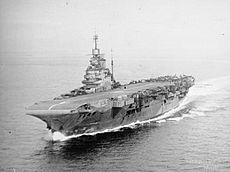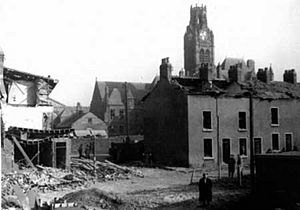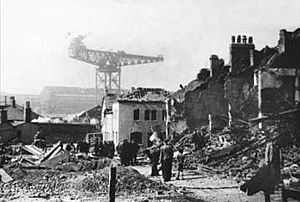Barrow Blitz facts for kids
The Barrow Blitz was a series of bombings by the German air force, called the Luftwaffe, on the town of Barrow-in-Furness, United Kingdom. This happened during World War II. The main attacks took place in April and May 1941. However, the first bombing happened earlier, in September 1940. The main targets were the VSEL shipyard and Barrow's steelworks. These were very important for making ships and steel for the war effort.
Contents
Why Barrow Was a Target
Many people in Barrow believed that the Germans were interested in their town even before the war. In May 1936, a huge German airship called the Hindenburg flew very low over Barrow. It moved slowly, and many locals thought it was spying on the shipyard. The Germans said it was just a luxury trip for passengers.
Barrow was a town of about 75,000 people in 1941. It was a major target for the Luftwaffe because of its shipbuilding industry. Barrow was one of the best places in the world for building ships. It made many submarines and ships for the Royal Navy, Britain's navy. This made it a very important place for the Germans to attack.

Defending the Town
During World War II, Walney Island near Barrow had two important coastal artillery forts. These were Hilpsford Fort and Fort Walney. Many small concrete shelters, called pillboxes, can still be seen along the Walney coastline today. They were used as lookouts and held rifles and machine guns. These weapons helped defend Barrow from the Luftwaffe.
Shipyard workers could use a large underground air-raid shelter for safety. Its entrance can still be found in a car park today. The Barrow/Walney Island Airport also had a large unit of the Royal Air Force. This airport was made bigger during the war to help Britain's air defences.
The Main Attacks
It was hard for the German bombers to hit only the shipyard. This meant that many homes and neighbourhoods were bombed instead. During the Blitz, 83 civilians were killed and 330 were injured. Over 10,000 houses were damaged or destroyed. This was about a quarter of all the homes in Barrow.
Sometimes, nearby towns and villages were bombed by mistake. Many streets in Barrow were badly damaged. In mid-April 1941, bombs caused a lot of damage to Abbey Road. The Waverley Hotel, Christ Church, and the Abbey Road Baptist Church were all completely destroyed. The town's main public baths and the Essoldo Theatre were also badly hit. Luckily, they were repaired within a few years.
Barrow was not very prepared for the Blitz. There were only enough public shelters for 5 percent of the town's people. Some people living in the town centre had to hide in hedgerows on the edge of town. This lack of shelters led to many more injuries and deaths. Two fire watchers were killed in May 1941. They were in a tall crane at Vickers Shipyard when it was bombed.
The main office for Barrow's anti-aircraft defences was in the Furness Abbey Hotel. This hotel was next to the old railway station, hidden by trees. It seemed like an unlikely target. But in May 1941, it was attacked and badly damaged by the Luftwaffe. Most of the hotel was later pulled down. The part that was left became a pub and restaurant. Barrow Central Station was also heavily damaged on May 7, 1941. A war memorial inside the station still shows holes and marks from the bombs.

Life After the Blitz
A local housewife named Nella Last wrote a diary about her daily life during the war. Her writings were later made into a television show.
Stella Rimington, who later became the head of MI5 (a British security service), moved to Barrow when she was four years old. She lived there during the Blitz. She remembered hiding under the stairs, windows blowing out, and ceilings falling down. On very bad nights, she had to walk through bombed areas to reach an air raid shelter.
Barrow's main war memorial is a cenotaph in Barrow Park. It lists the names of hundreds of people from Barrow who died in different wars. This includes 616 in the First World War, 268 in the Second World War, and 6 in the Korean War. The Dock Museum in Hindpool has an exhibit about the Barrow Blitz.
Key Dates
Here is a timeline of important events during the Barrow Blitz:
- September 1940
- The first required blackout happened in Barrow. This meant all lights had to be turned off at night.
- 300 incendiary bombs (bombs designed to start fires) were dropped on Salthouse. A 5-year-old child became the first victim of the Barrow Blitz.
- May 1941
- Bombing became much worse. The Luftwaffe dropped land-mines, incendiaries, and high explosives.
- Barrow Central railway station was completely destroyed by bombing.
- About 2,250 children were sent away from the town for safety.
- June 1941
- Another 4,000 children were sent away. The number of deaths from bombing went over 80.
- January 1942
- The last bombs of the Blitz were dropped on Barrow. No one was recorded as being hurt.
- March 1942
- The last air-raid siren (a warning sound) in Barrow was heard on March 25.
See also
- The Blitz
- Barrow Park Cenotaph
- Timeline of Barrow-in-Furness
- Housewife, 49
- Vickers Ltd. Shipbuilding
- Barrow/Walney Island Airport



